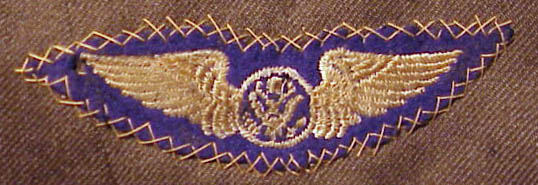





There were a number of styles of manufacture of wing badges used during the Second World. The most familiar are metallic ones that were often made of Sterling Silver. These are sometimes marked with the name of the manufacturer. Either pin backed or clutch backed varieties exist. In addition to metallic wings bullion embroidered wing were also common. During the prewar years there was a concern about things becoming snagged on metallic insignia and embroidered insignia were favored by aviators. However, by the time of the Second World War aviators were wearing flight suits while in the air and metallic insignia were no problem on service uniforms. Even so, embroidered wing badges remained in use and are not uncommon. In the European Theater of Operations combat aircrews wore their wing badges on a blue rectangle. Embroidered wing badges were sometimes embroidered directly on blue material. Some wing badges were machine embroidered in white cotton on olive drab or khaki. Examples of cotton hand embroidered on khaki also exist and are often encountered on khaki shirts from the China-Burma-India Theater. Finally, wings were tooled on leather for wear on flight suits.
Wings were made in three common sizes. The largest three inch wings (regulation size actually three and one-eighth) were worn on coats, the middle two inch size on shirts and the smallest one inch size on caps or given as tokens to sweethearts.